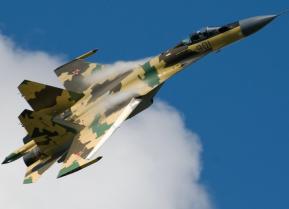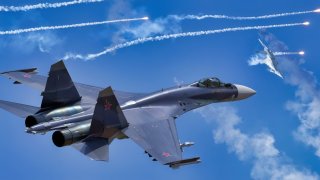Su-27: The Russian Warplane That Is a True Legend
Russia’s Sukhoi Su-27 has patrolled the skies over Russia and Ukraine for years, initially under the purview of the Soviet Union and now as a fighter for both Moscow and Kyiv.
The White House recently agreed to allow Ukrainian pilots to fly F-16 Fighting Falcon fighter jets, highlighting the role airframes are playing in the ongoing Russian invasion. In late May, Moscow claimed that it scrambled an Su-27 fighter to “prevent violations” of the state border by a pair of American strategic bombers flying over the Baltic Sea.
The Pentagon responded that the two B-1 bombers were participating in a planned exercise in Europe, marking the latest in a series of incidents surrounding Russian, American and North Atlantic Treaty Organization (NATO) airframes since the onset of the war.
Russia’s Sukhoi Su-27 has patrolled the skies over Russia and Ukraine for years, initially under the purview of the Soviet Union and now as a fighter for both Moscow and Kyiv.
A brief overview of the Su-27’s history
Designed to effectively counter America’s fourth-generation F-14 Tomcat and F-15 Eagle platforms, the Su-27’s origin story dates back to the Soviet Union.
When the former USSR discovered the U.S. Air Force was developing the F-15 under its “F-X” program, Soviet engineers went to work to design its own indigenous fighter.
The Russian company Sukhoi developed its T-10 prototype in the late 1970’s, which strongly resembled the F-15’s specifications.
Designated by NATO as “Flanker-A,” the T-10 airframe suffered from several significant issues during its development stage, including the fatal crash of its second prototype. By the mid-1980’s, however, the platform entered service with the USSR and was officially unveiled to the West at the 1989 Paris Air Show.
Eventually, the Flanker-A would become the Su-27. The Sukhoi defense giant competed against two other recognizable Soviet companies, Mikoyan and Yakolev.
The Flanker-A’s specs and capabilities
Over the years, the Su-27 has evolved into several newer variants, including the Su-34 fighter bomber and the fourth-generation plus Su-35.
Able to operate autonomously in combat or in tandem with deep-penetration strike platforms, the Flanker-A can also provide close ground support. The Su-27 possesses several features that lower its radar signature, including a rounded noise, dual-engine integration and nearly horizontal wing-body structure.
Like the notoriously formidable American F-22 Raptor, the Su-27’s smaller radar cross section makes it more difficult for enemy airframes to detect. Twin turbofan engines power the Flanker-A, which enables the airframe to achieve a service ceiling of 18,000 meters and a flight range of more than 1,800 miles.
The Su-27 also sports track-while-scan capabilities and other more advanced sensors and communication systems than some of its predecessors.

Ordnance-wise, the Su-27 can function as a “bomb truck” of sorts. As detailed by Airforce Technology, “The aircraft is equipped with a 30mm GSh-301 gun with 150 rounds of ammunition and a range of missiles, rockets and bombs mounted externally on ten hardpoints.
The aircraft’s infrared search and track system, laser rangefinder, radar and helmet-mounted target designator provide detection, tracking and attack capability.” In addition to a range of air-to-air missiles, the platform can carry air-to-ground weapons including aerial bombs, incendiary devices, cluster bombs and aerial missiles.

As Kyiv’s counter-offensive wages on and F-16s make it to Ukraine, Moscow will likely turn more to its aerial fleet to continue its offensive efforts.
About the Author
Maya Carlin is an analyst with the Center for Security Policy and a former Anna Sobol Levy Fellow at IDC Herzliya in Israel. She has by-lines in many publications, including The National Interest, Jerusalem Post, and Times of Israel. You can follow her on Twitter: @MayaCarlin.
Main Image is an Artist's Image from Shutterstock. All other images are Creative Commons.


